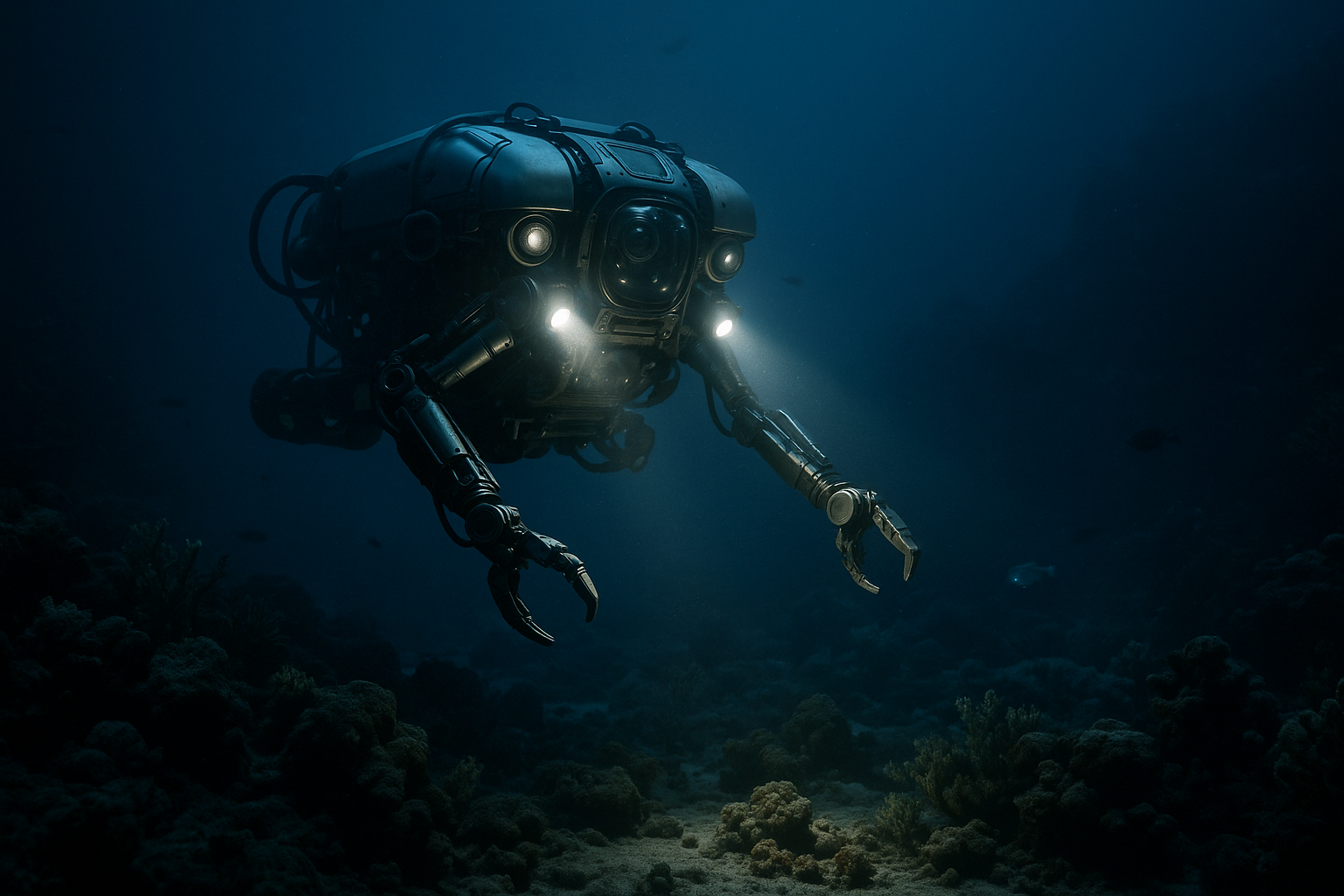In the vast, uncharted realms beneath the ocean’s surface lies a world as mysterious as it is captivating. It’s a place where sunlight fades into oblivion, and the pressure mounts with each descending meter, creating an environment that demands respect and careful navigation. For centuries, humankind has been drawn to these deep waters, driven by a desire to explore the unknown, discover hidden wonders, and unlock the secrets of the ocean’s depths. Yet, as thrilling as these adventures may be, they come with significant risks, one of the most critical being the challenge of managing decompression effectively. This article delves into the art and science of mastering decompression in deep explorations, providing insights and strategies for ensuring safety and success beneath the waves. 🌊
Decompression sickness, often referred to as “the bends,” is a potentially life-threatening condition that can occur when divers ascend too quickly from deep waters. The deeper and longer the dive, the greater the risk. But fear not, for the mysteries of decompression have been extensively studied, and with the right knowledge and preparation, it can be managed effectively. This article will guide you through the essentials of decompression management, exploring the physiological impacts of pressure changes, the development and application of decompression models, and the use of technology to monitor and mitigate risks. Whether you’re an experienced diver or a curious novice, understanding these elements is crucial for anyone venturing into the depths.
Throughout this comprehensive exploration, we will also examine the latest advancements in diving technology, the role of dive computers in real-time monitoring, and the importance of tailored decompression schedules. We will share stories of explorers who have pushed the boundaries of deep-sea diving, learning from both their triumphs and their challenges. Additionally, we will highlight the significance of proper training and the psychological aspects of diving, emphasizing the need for a calm and focused mindset when navigating the underwater world. By the end of this article, you will not only have a deeper understanding of how to manage decompression safely but also a renewed appreciation for the wonders and responsibilities that come with exploring the ocean’s depths. Dive in with us as we unravel the complexities of decompression and empower you with the knowledge to explore safely and confidently. 🌐
The Science Behind Decompression in Deep Explorations
When diving into the depths of the ocean, or exploring vast underground caves, managing decompression is a critical aspect of ensuring safety. Decompression is the reduction of ambient pressure experienced by divers and explorers as they ascend from deep to shallower environments. The concept is straightforward, yet its implications are vast and complex. The deeper and longer a person stays underwater or within a pressurized environment, the more nitrogen their body absorbs. This nitrogen must be released gradually to prevent decompression sickness (DCS), a condition that can cause serious harm and even be fatal.
Decompression sickness occurs when nitrogen bubbles form in the tissues of the body due to a rapid decrease in pressure. This phenomenon is not exclusive to divers but can also affect astronauts and miners. The symptoms can range from joint pain and rashes to paralysis and death, making it essential for individuals involved in deep explorations to follow strict decompression protocols. These protocols are designed to allow the body to off-gas the absorbed nitrogen safely, minimizing the risk of DCS.
The physical principles governing decompression are rooted in Henry’s Law, which states that the amount of gas dissolved in a liquid is proportional to the pressure of the gas above the liquid. In practical terms, this means that at higher pressures, more nitrogen dissolves in the blood and tissues, and as the pressure decreases, this nitrogen must be released carefully. To better understand this, check out the video below from the “Divers Alert Network” on YouTube, which explains the science of decompression sickness: Understanding Decompression Sickness – Divers Alert Network.
Techniques for Effective Decompression Management
Managing decompression effectively requires meticulous planning and execution. There are several techniques and strategies employed by divers and explorers to minimize the risk of DCS. The choice of technique often depends on the depth and duration of the dive or exploration, as well as the specific conditions of the environment.
One widely used method is the “decompression stop” technique. This involves making scheduled stops at various depths during ascent to allow the body to expel nitrogen safely. These stops are calculated based on dive tables or dive computers that take into account the depth and duration of the dive. Dive computers have become increasingly sophisticated, offering real-time data and alerts to help divers adhere to safe ascent profiles. A dive computer, for instance, will display the recommended decompression stops and durations, adjusting dynamically as conditions change.
Another technique is the use of “nitrox” or enriched air, which contains a higher concentration of oxygen than regular air. This reduces the amount of nitrogen absorbed during a dive, thereby lowering the risk of DCS and allowing for longer bottom times. While using nitrox requires additional training and certification, it is a popular choice among recreational and professional divers alike for its benefits in managing decompression.
Table: Comparison of Decompression Techniques
TechniqueAdvantagesDisadvantagesDecompression StopsCustomizable, based on depth and time; widely used and understoodRequires precise timing and monitoring; can be time-consumingNitrox DivingReduces nitrogen absorption; allows longer divesRequires certification; equipment and training costs
For a more comprehensive understanding of how these techniques are applied in practice, watch this informative video from the “Dive Gear Reviews” channel, which covers various decompression strategies: Decompression Diving Techniques – Dive Gear Reviews.
Challenges and Innovations in Decompression Management
While existing decompression techniques are effective, they are not without challenges. One significant challenge is the inherent unpredictability of individual responses to decompression. Factors such as age, fitness level, hydration, and even genetics can influence how a person’s body handles decompression. This variability makes it difficult to develop one-size-fits-all protocols, necessitating a personalized approach for each diver or explorer.
Innovations in technology are continuously enhancing decompression management. Advanced dive computers now incorporate algorithms that adapt to the diver’s physiology, using data such as heart rate and skin temperature to provide more accurate decompression guidance. Some models are even equipped with wireless connectivity, allowing for real-time monitoring and adjustments during the dive. This technological evolution is a testament to the ongoing efforts to improve safety and efficiency in decompression management.
Furthermore, research into alternative breathing gases is opening new avenues for safer deep explorations. Heliox and trimix, for instance, are gas mixtures used in deep diving to reduce the narcotic effects of nitrogen and the risks of oxygen toxicity. These mixtures allow for deeper dives with safer decompression profiles, although they require specialized training and equipment.
To see these innovations in action, and learn more about how they’re shaping the future of deep explorations, check out the video below from the “Tech Diving Magazine” channel: Innovations in Diving Technology – Tech Diving Magazine.
The Role of Training and Education in Decompression Safety
Proper training and education are paramount for effective decompression management. Divers and explorers must understand the principles of decompression theory, as well as the practical application of decompression techniques. Training programs, such as those offered by the Professional Association of Diving Instructors (PADI) and the National Association of Underwater Instructors (NAUI), provide comprehensive courses on decompression diving, including the use of dive tables, computers, and alternative breathing gases.
These programs emphasize the importance of pre-dive planning, which includes assessing dive conditions, selecting appropriate equipment, and establishing a clear ascent strategy. Regular drills and simulations are also incorporated to ensure divers can respond effectively in emergency situations. Additionally, ongoing education is encouraged to keep divers updated on the latest developments and best practices in decompression management.
- Importance of pre-dive planning and assessment
- Role of drills and emergency simulations
- Benefits of advanced technical diving courses
To get a glimpse into a technical diving course and see what it entails, watch this video from the “Technical Diving International” channel: Inside a Technical Diving Course – Technical Diving International.

Conclusion: Mastering the Depths: How to Effectively Manage Decompression in Deep Explorations
In this comprehensive exploration of decompression management in deep-sea and high-altitude environments, we have navigated through the intricacies of a topic that is as critical as it is fascinating. Decompression, a physiological phenomenon that occurs when transitioning from high-pressure environments to normal atmospheric pressure, poses significant challenges and risks. Understanding how to effectively manage these transitions is essential for the safety and success of any deep exploration mission, whether it’s underwater or into the skies.
We began by highlighting the historical context and the evolution of decompression theories. From the early days of diving, when the dangers of decompression sickness were not yet fully understood, to the modern-day advancements in science and technology, we have come a long way. The development of the decompression tables and algorithms has significantly enhanced our ability to predict and prevent decompression-related incidents.
Next, we delved into the physiological aspects of decompression. We examined how the human body responds to changes in pressure, the role of inert gases like nitrogen, and the importance of controlled ascents and descents. By understanding the science behind decompression, we can better appreciate the techniques and technologies designed to mitigate its risks.
We then explored the various strategies and tools used in effective decompression management. From dive computers and decompression chambers to innovative breathing gas mixtures and wearable sensors, the arsenal available to divers and explorers has never been more advanced. These tools not only enhance safety but also extend the possibilities of human exploration into previously unreachable depths.
Furthermore, we discussed the importance of training and preparedness. Even with the best technology, human error can lead to serious incidents. Comprehensive training programs and simulation exercises are crucial in ensuring that divers and explorers are prepared for any eventuality. Through rigorous practice and education, we can instill a culture of safety and readiness.
The role of international collaboration and research cannot be understated. Organizations and institutions around the world are constantly pushing the boundaries of what we know about decompression. By sharing knowledge and resources, we can collectively improve safety standards and innovate new solutions.
The societal and environmental impacts of deep explorations also warrant consideration. As we continue to explore the depths of our oceans and the heights of our atmosphere, we must do so responsibly. Protecting marine ecosystems and ensuring sustainable practices are integral to the long-term success of these endeavors.
Finally, we touched on the future of decompression management. With ongoing advancements in AI, robotics, and biotechnology, the future holds exciting possibilities. These technologies promise to further enhance our capabilities and safety, opening new frontiers for exploration.
In conclusion, mastering the depths requires a multifaceted approach that combines scientific knowledge, technological innovation, rigorous training, and international cooperation. The journey is challenging, but the rewards are immense. As we continue to push the boundaries of human exploration, understanding and effectively managing decompression will remain a cornerstone of our endeavors.
This topic is not just for those directly involved in deep explorations but is of interest to anyone fascinated by the limits of human potential and the wonders of our planet. We encourage you to share this knowledge with others, whether through discussions, social media, or educational platforms. By spreading awareness, we can foster a community that values safety and innovation in exploration.
Thank you for joining us on this deep dive into the world of decompression management. Your thoughts and insights are valuable to us, so please feel free to leave a comment below. Let’s continue the conversation and explore together! 🚀🌊
For further reading and resources, check out these active links:
– National Oceanic and Atmospheric Administration (NOAA)
– The Undersea & Hyperbaric Medical Society
We look forward to hearing from you! 🌟
Gabriel is a visual storyteller and archival artist whose lens dives deep into the submerged echoes of underwater archaeology. Through sediment and salt, Gabriel traces forgotten histories — those whispered by shipwrecks, eroded artifacts, and drowned cities.
Compelled by the allure of ancient trade routes, submerged sanctuaries, and the ocean’s quiet possession of the past, Gabriel’s work charts a poetic cartography of the sea’s memory. From coral-laced amphorae to oxidized anchors, every object he illuminates becomes part of a narrative where time collapses and the past drifts close.
His creations are more than documentation — they are visual meditations on absence and endurance. Gabriel blends design, historical research, and storytelling to surface the quiet resilience of maritime remnants. He captures the textures of time: rust that blooms like algae, stone that crumbles into myth, and silence that speaks louder than ruin.
Through curated imagery, thoughtful essays, and reconstructed impressions of what lies beneath, Gabriel invites viewers to see underwater ruins not as remnants, but as thresholds to wonder — places where memory is refracted through water, and where myth lingers like salt on stone.
His practice is a tribute to:
The unknowable depths of civilizations consumed by tides
The fragile endurance of objects left behind
The enduring dialogue between water, stone, and remembrance
If your soul drifts toward the relics of lost maritime empires, the mythic pull of coastal rituals, or the ghostly grace of sunken vessels, Gabriel welcomes you to descend into a space where history sleeps in sediment — but dreams in currents.




